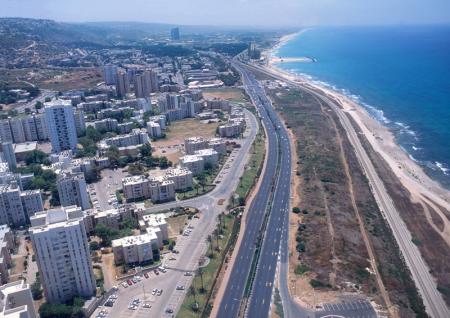Upgrade of the HAGANA Arterial in the City of Haifa
Project Name
Upgrade of the HAGANA Arterial in the City of Haifa
Field of Activity
Final Design
Specialization
Metropolitan and Urban Projects
Client
YEFE NOF Ltd.
Location
Israel
Project Duration
2001-staged ongoing
Project Cost
US$ 50 million

|
Services Provided:
|
|
Haifa, Israel third largest city, is located on the west-northern slopes of the Carmel Mountain. The Haifa Metropolitan Area extends mainly to north and east of the city, covering about 15 different cities, towns and localities, administratively organized as independent municipalities and regional councils. However, there are strong commuting ties between these population centers and the city of Haifa as the metropolitan core.
The HAGANA Road is the Haifa sole southern access, formed by merging of national routes Nos. 2 & 4. Its layout runs along the Mediterranean coastline in parallel to the coastline railroad, between the sea shore and the Haifa western residential areas located on the western slopes of the Carmel mountain. Together with the coastline railroad the HAGANA road composes a primary transport corridor which, after penetrating the Haifa downtown, connects to main arterials leading up north and east of the country. |
The project discussed below encompasses the widening of the 7.0km long HAGANA road as a dual carriageway from 2x2 to 2x3 lanes, with one lane in each direction dedicated exclusively for public transport.
The HAGANA road is connected to several arterial branching out from the Carmel ridge by at level signalized intersections. Considering foreseen development of adjacent areas the project encompasses, apart of widening the road, the replacing of these intersections by 5 interchanges to enable smooth traffic flow, thus forming an urban freeway. The entire project implementation is carried out in a staged fashion, subject to multi-annual budget allocation. So far the following components have been carried out:
|
|
|

ALENBY Interchange Final Layout Plan
|

ALENBY Interchange
(Stage 1 - completed 2004) |
|
|
|
Another major component designed by TEDEM and implemented earlier (in the 1990s) is the DOLPHIN underpass. This project enabled eliminating an at level railway crossing at the main entrance to the Haifa Port and the BAT GALIM residential quarter, foreseeing a significant train frequency increase. The design was a particularly difficult one due to proximity to the sea shore with the road going under the sea level, resulting with a high ground water level.
Additional interchanges planned along the HAGANA roads have not yet been designated for construction and are in various stages of preliminary design. The HAGANA road project was divided by the commissioning authority YEFE NOF into segments and TEDEM was chosen as the principal designer for the majority the project sections (4.5 km), including all five interchanges. In parallel; TEDEM integrates its scope of work with other consulting firms responsible for the remnant components of the entire project. |
HAGANA Road Upgrade
The DOLPHIN Underpass |
|
|
|
In the framework of its role in the project, TEDEM has been providing the following services:
|
On top of all design components performed directly by TEDEM, the company has been coordinating and guiding various sub-consultants in the fields of:
|
Back
